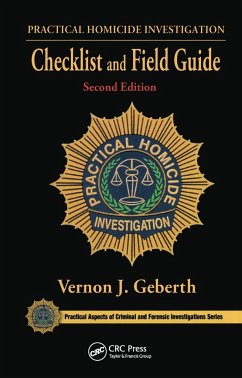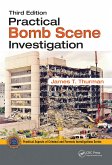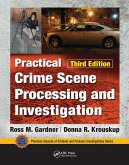Vernon J. Geberth, ummer Steven B., Karch Olaf
Practical Homicide Investigation Checklist and Field Guide
Vernon J. Geberth, ummer Steven B., Karch Olaf
Practical Homicide Investigation Checklist and Field Guide
- Gebundenes Buch
- Merkliste
- Auf die Merkliste
- Bewerten Bewerten
- Teilen
- Produkt teilen
- Produkterinnerung
- Produkterinnerung
This book provides protocols for suicide and equivocal death investigation, police action shooting investigations and a homicide supervisor's checklist. It contains state-of-the-art anatomical graphics in full color to assist the investigator in describing any injuries or wounds to the body.
Andere Kunden interessierten sich auch für
![Practical Cold Case Homicide Investigations Procedural Manual Practical Cold Case Homicide Investigations Procedural Manual]() Richard H. WaltonPractical Cold Case Homicide Investigations Procedural Manual237,99 €
Richard H. WaltonPractical Cold Case Homicide Investigations Procedural Manual237,99 €![Practical Homicide Investigation Practical Homicide Investigation]() Vernon J. Geberth (Practical Homicide Investigation, Inc., New YorkPractical Homicide Investigation147,99 €
Vernon J. Geberth (Practical Homicide Investigation, Inc., New YorkPractical Homicide Investigation147,99 €![Practical Bomb Scene Investigation Practical Bomb Scene Investigation]() James T. Thurman (Eastern Kentucky University, Richmond, USA)Practical Bomb Scene Investigation89,99 €
James T. Thurman (Eastern Kentucky University, Richmond, USA)Practical Bomb Scene Investigation89,99 €![Practical Aspects of Rape Investigation Practical Aspects of Rape Investigation]() Practical Aspects of Rape Investigation96,99 €
Practical Aspects of Rape Investigation96,99 €![Crime Scene Staging Dynamics in Homicide Cases Crime Scene Staging Dynamics in Homicide Cases]() Laura Gail PettlerCrime Scene Staging Dynamics in Homicide Cases51,99 €
Laura Gail PettlerCrime Scene Staging Dynamics in Homicide Cases51,99 €![Quantitative-Qualitative Friction Ridge Analysis Quantitative-Qualitative Friction Ridge Analysis]() David R. Ashbaugh (British Columbia Ridgeology Consulting ServicesQuantitative-Qualitative Friction Ridge Analysis77,99 €
David R. Ashbaugh (British Columbia Ridgeology Consulting ServicesQuantitative-Qualitative Friction Ridge Analysis77,99 €![Practical Crime Scene Processing and Investigation, Third Edition Practical Crime Scene Processing and Investigation, Third Edition]() Ross M. Gardner (former felony criminal investigator at the U.S. ArPractical Crime Scene Processing and Investigation, Third Edition106,99 €
Ross M. Gardner (former felony criminal investigator at the U.S. ArPractical Crime Scene Processing and Investigation, Third Edition106,99 €-
-
-
This book provides protocols for suicide and equivocal death investigation, police action shooting investigations and a homicide supervisor's checklist. It contains state-of-the-art anatomical graphics in full color to assist the investigator in describing any injuries or wounds to the body.
Hinweis: Dieser Artikel kann nur an eine deutsche Lieferadresse ausgeliefert werden.
Hinweis: Dieser Artikel kann nur an eine deutsche Lieferadresse ausgeliefert werden.
Produktdetails
- Produktdetails
- Practical Aspects of Criminal and Forensic Investigations
- Verlag: Taylor & Francis Ltd
- 2 ed
- Seitenzahl: 170
- Erscheinungstermin: 2. Oktober 2019
- Englisch
- Abmessung: 144mm x 222mm x 15mm
- Gewicht: 378g
- ISBN-13: 9781138415775
- ISBN-10: 1138415774
- Artikelnr.: 58058927
- Herstellerkennzeichnung
- Libri GmbH
- Europaallee 1
- 36244 Bad Hersfeld
- gpsr@libri.de
- Practical Aspects of Criminal and Forensic Investigations
- Verlag: Taylor & Francis Ltd
- 2 ed
- Seitenzahl: 170
- Erscheinungstermin: 2. Oktober 2019
- Englisch
- Abmessung: 144mm x 222mm x 15mm
- Gewicht: 378g
- ISBN-13: 9781138415775
- ISBN-10: 1138415774
- Artikelnr.: 58058927
- Herstellerkennzeichnung
- Libri GmbH
- Europaallee 1
- 36244 Bad Hersfeld
- gpsr@libri.de
Geberth, Vernon J.
THE CHECKLIST APPROACH TO HOMICIDE INVESTIGATION
THE HOMICIDE CRIME SCENE
Introduction
The Crime Scene
THE PATROL OFFICER'S DUTIES
First Officer's Duties upon Arrival
Protection of Life
Patrol Officer Establishing the Crime Scene
Protecting the Crime Scene
Trie Crime Scene Sign
In Sheet
The First Officer Initiates the Homicide Investigation
Recommended Procedures to Initiate the Investigation
Patrol Officer's Quicklist
The Patrol Officer's Checklist
Initial Call and Receipt of Information
Arrival at the Homicide Crime Scene
Protection of the Crime Scene
Notifications
Preliminary Investigation
The Suspect in Custody
Suicide and Accidental Deaths
THE PRELIMINARY INVESTIGATION AT THE SCENE
The Detectives
Initial Receipt of Information
Prior to Leaving for the Crime Scene, Instruct Patrol To
Arrival at the Scene
THE INVESTIGATIVE CHECKLIST
Documentation of the Initial Report
Initial Receipt of Information
Arrival at the Homicide Scene
Preliminary Inspection of the Body at the Crime Scene
Implement Crime Scene Control Procedures
Initiate a Crime Scene Log
Establish a Policy for Crime Scene Integrity
Establish a Command Post or Temporary Headquarters
EMS and Ambulance Personnel
Initiate a Canvass
Weapons
The Suspect in Custody
The Suspect in Custody: Interrogation at the Scene
Crime Scene Photographs
Documentation of Crime Scene Photographs
The Crime Scene Sketch
The Crime Scene Search
Dust for Fingerprints
Description of the Deceased
Victim and Hospital Information
Evidence Process and Control Procedures
Release of the Homicide Crime Scene
D U T I E S OF T H E DETECTIVE SUPERVISOR U P O N
ARRIVAL AT T H E SCENE
SPECIFIC INVESTIGATIVE D U T I E S AT T H E SCENE
The Suspect in Custody
Evaluation of the Suspect's Demeanor and Mental Capacity
Obtaining a D y i n g Declaration
Questions to Be Asked in a Dying Declaration
Documentation of the Dying Declaration
SUICIDE INVESTIGATION
Three Investigative Considerations in Determining the
Manner of Death (Homicide or Suicide)
Suicide Notes
Suicide Checklist
Investigative Considerations
Evaluation of the Wounds
Weapons or Means of Death
Psychological Aspects
Warning Signs in Suicide
Extreme Danger Signs
Psychological State of the Victim
Spite Suicides
Any Prior Mental Disease or Defect
Consider a Psychological Autopsy
FINAL EXIT SUICIDES
Investigative Checklist for Final Exit Cases
The Plastic Bag
SUICIDE
BY
COP SCENARIOS
Some Suicide Indicators
AUTOEROTIC FATALITIES
Investigative Considerations
Autoerotic Checklist: Determining the Involvement of
Sexual Asphyxia
INVESTIGATING FATAL FIRES CHECKLIST
Investigative Considerations
The Fire Incident
Suspicious Designation: General Determination Factors
Maintenance of the Fire Crime Scene
Investigation at the Scene
Determination of Arson
SUDDEN INFANT DEATH SYNDROME (SIDS)
Investigative Checklist
MUNCHAUSEN SYNDROME BY PROXY
Warning Signs
CRIME SCENE DOCUMENTATION
Documentation of Crime Scene Photographs
Recommended Crime Scene Photographs
Photographs of Deceased Subjects
Videotape Protocol
Arrival at Scene
Taping Protocol Checklist
DOCUMENTATION OF THE CRIME SCENE SKETCH
l h e Title Block
Formulating the Search
Examination of the Outdoor Crime Scene
Investigative Questions
Examination of the Body at the Scene
The Head
The Trunk
Arms and Legs
The Wound Chart
Gunshot Wounds
Intermediate
Range Wounds
Cutting Wounds
Blunt Force Injuries
Asphyxiai Deaths
RECOMMENDATIONS AND GUIDELINES FOR PROPER
DEATH NOTIFICATIONS TO SURVIVING FAMILY
MEMBERS
SEX
RELATED HOMICIDE INVESTIGATION
Investigative Considerations
The Crime Scene Investigation
Sex
Related Crime Scene Checklist
MEDICOLEGAL CONSIDERATIONS
Examination of the Crime Scene
Descriptive Information
Anatomical Figures
SUPERVISOR'S HOMICIDE CHECKLIST
Supervising the Preliminary Investigation at the Scene: The
Checklist
Directing Specific Investigative Duties Il l
The Suspect in Custody Ill
Examination of a Suspect for Evidence
Evaluation of a Suspect's Demeanor and/or Mental Capacity
Supervising a Homicide Crime Scene Search
Crime Scene Considerations
Release of the Body
Examining an Outdoor Crime Scene
Release of the Crime Scene
INVESTIGATION OF POLICE
RELATED SHOOTINGS
Officer
Involved Shootings (OISs) and Use of Deadly Force
Incidents
The Protocol
Introduction
Assigning Investigative Responsibility
INVESTIGATION OF OISS AND USE OF DEADLY FORCE
INCIDENTS
Supervisory Responsibilities
Checklist
Incident Scene Investigator(s)
Checklist
Interview of Employee(s) Involved
Taped Interview of Employee(s) Involved
Follow
Up Investigation
Background Investigation
Suspect(s) and Witnesses
Employee(s)
Preparation of Investigative Report
APPENDIX: PROCEDURES FOR THE COLLECTION
OF EVIDENCE
COLLECTION OF SPECIFIC TYPES OF EVIDENCE
Body Materials
Blood (Wet)
Bloodstains (Dry)
Nonporous Surface
Porous Surface (Fabric, Unfinished Wood, etc.)
Traces or Smears That Cannot Be Scraped into Container
Semen
Semen Wet Stain
Semen Dry Stain
Urine
Spittle or Saliva
Feces
Large Amount
Small Amount
Vomit
Tissue
Hair
Collection of Hairs from the Scene
Objects
Bullets
Discharged Casings or Cartridges
Shotgun Shells
Live Cartridges or Rounds of Ammunition
Shotgun Wadding
Weapons
Firearms
Fibers
Fabric
Clothing
Cigarette or Cigar Butts
Displaced Furniture
Insects
Common Insects Found on Human Remains and at Crime Scenes
Investigative Considerations
Equipment
Procedures
Soil
Collection of Soil Samples
Tools
Vehicles
Documents (Letters, Notes, and Papers)
Glass
Impressions
Fingerprint Examination
Types of Fingerprints
Development of Fingerprints
Chemical Processes
Tire Tracks and Footprints
Tool Marks
Newly Damaged Areas
Collection of Bite
Mark Evidence at the Scene
Photographs of the Bite
Mark Wound
Saliva Washings
Bloodstain Pattern Analysis (Examination of Blood Spatter)
Investigative Considerations
Crime Scene Examination
Crime Scene Documentation
CRIME SCENE COLLECTION OF ELECTRONIC AND
DIGITAL E V I D E N C E
Investigative Considerations
Identification of Digital Evidence
Additional Investigative Considerations
Volatile Data Collection Strategy for Powered
Up Computers
Computers
Collection Procedures
Cellular Phones
Investigative Considerations
Cellular Telephones in an Active Investigation
Cellular Telephones in Nonactive Investigations
NOTES.
THE HOMICIDE CRIME SCENE
Introduction
The Crime Scene
THE PATROL OFFICER'S DUTIES
First Officer's Duties upon Arrival
Protection of Life
Patrol Officer Establishing the Crime Scene
Protecting the Crime Scene
Trie Crime Scene Sign
In Sheet
The First Officer Initiates the Homicide Investigation
Recommended Procedures to Initiate the Investigation
Patrol Officer's Quicklist
The Patrol Officer's Checklist
Initial Call and Receipt of Information
Arrival at the Homicide Crime Scene
Protection of the Crime Scene
Notifications
Preliminary Investigation
The Suspect in Custody
Suicide and Accidental Deaths
THE PRELIMINARY INVESTIGATION AT THE SCENE
The Detectives
Initial Receipt of Information
Prior to Leaving for the Crime Scene, Instruct Patrol To
Arrival at the Scene
THE INVESTIGATIVE CHECKLIST
Documentation of the Initial Report
Initial Receipt of Information
Arrival at the Homicide Scene
Preliminary Inspection of the Body at the Crime Scene
Implement Crime Scene Control Procedures
Initiate a Crime Scene Log
Establish a Policy for Crime Scene Integrity
Establish a Command Post or Temporary Headquarters
EMS and Ambulance Personnel
Initiate a Canvass
Weapons
The Suspect in Custody
The Suspect in Custody: Interrogation at the Scene
Crime Scene Photographs
Documentation of Crime Scene Photographs
The Crime Scene Sketch
The Crime Scene Search
Dust for Fingerprints
Description of the Deceased
Victim and Hospital Information
Evidence Process and Control Procedures
Release of the Homicide Crime Scene
D U T I E S OF T H E DETECTIVE SUPERVISOR U P O N
ARRIVAL AT T H E SCENE
SPECIFIC INVESTIGATIVE D U T I E S AT T H E SCENE
The Suspect in Custody
Evaluation of the Suspect's Demeanor and Mental Capacity
Obtaining a D y i n g Declaration
Questions to Be Asked in a Dying Declaration
Documentation of the Dying Declaration
SUICIDE INVESTIGATION
Three Investigative Considerations in Determining the
Manner of Death (Homicide or Suicide)
Suicide Notes
Suicide Checklist
Investigative Considerations
Evaluation of the Wounds
Weapons or Means of Death
Psychological Aspects
Warning Signs in Suicide
Extreme Danger Signs
Psychological State of the Victim
Spite Suicides
Any Prior Mental Disease or Defect
Consider a Psychological Autopsy
FINAL EXIT SUICIDES
Investigative Checklist for Final Exit Cases
The Plastic Bag
SUICIDE
BY
COP SCENARIOS
Some Suicide Indicators
AUTOEROTIC FATALITIES
Investigative Considerations
Autoerotic Checklist: Determining the Involvement of
Sexual Asphyxia
INVESTIGATING FATAL FIRES CHECKLIST
Investigative Considerations
The Fire Incident
Suspicious Designation: General Determination Factors
Maintenance of the Fire Crime Scene
Investigation at the Scene
Determination of Arson
SUDDEN INFANT DEATH SYNDROME (SIDS)
Investigative Checklist
MUNCHAUSEN SYNDROME BY PROXY
Warning Signs
CRIME SCENE DOCUMENTATION
Documentation of Crime Scene Photographs
Recommended Crime Scene Photographs
Photographs of Deceased Subjects
Videotape Protocol
Arrival at Scene
Taping Protocol Checklist
DOCUMENTATION OF THE CRIME SCENE SKETCH
l h e Title Block
Formulating the Search
Examination of the Outdoor Crime Scene
Investigative Questions
Examination of the Body at the Scene
The Head
The Trunk
Arms and Legs
The Wound Chart
Gunshot Wounds
Intermediate
Range Wounds
Cutting Wounds
Blunt Force Injuries
Asphyxiai Deaths
RECOMMENDATIONS AND GUIDELINES FOR PROPER
DEATH NOTIFICATIONS TO SURVIVING FAMILY
MEMBERS
SEX
RELATED HOMICIDE INVESTIGATION
Investigative Considerations
The Crime Scene Investigation
Sex
Related Crime Scene Checklist
MEDICOLEGAL CONSIDERATIONS
Examination of the Crime Scene
Descriptive Information
Anatomical Figures
SUPERVISOR'S HOMICIDE CHECKLIST
Supervising the Preliminary Investigation at the Scene: The
Checklist
Directing Specific Investigative Duties Il l
The Suspect in Custody Ill
Examination of a Suspect for Evidence
Evaluation of a Suspect's Demeanor and/or Mental Capacity
Supervising a Homicide Crime Scene Search
Crime Scene Considerations
Release of the Body
Examining an Outdoor Crime Scene
Release of the Crime Scene
INVESTIGATION OF POLICE
RELATED SHOOTINGS
Officer
Involved Shootings (OISs) and Use of Deadly Force
Incidents
The Protocol
Introduction
Assigning Investigative Responsibility
INVESTIGATION OF OISS AND USE OF DEADLY FORCE
INCIDENTS
Supervisory Responsibilities
Checklist
Incident Scene Investigator(s)
Checklist
Interview of Employee(s) Involved
Taped Interview of Employee(s) Involved
Follow
Up Investigation
Background Investigation
Suspect(s) and Witnesses
Employee(s)
Preparation of Investigative Report
APPENDIX: PROCEDURES FOR THE COLLECTION
OF EVIDENCE
COLLECTION OF SPECIFIC TYPES OF EVIDENCE
Body Materials
Blood (Wet)
Bloodstains (Dry)
Nonporous Surface
Porous Surface (Fabric, Unfinished Wood, etc.)
Traces or Smears That Cannot Be Scraped into Container
Semen
Semen Wet Stain
Semen Dry Stain
Urine
Spittle or Saliva
Feces
Large Amount
Small Amount
Vomit
Tissue
Hair
Collection of Hairs from the Scene
Objects
Bullets
Discharged Casings or Cartridges
Shotgun Shells
Live Cartridges or Rounds of Ammunition
Shotgun Wadding
Weapons
Firearms
Fibers
Fabric
Clothing
Cigarette or Cigar Butts
Displaced Furniture
Insects
Common Insects Found on Human Remains and at Crime Scenes
Investigative Considerations
Equipment
Procedures
Soil
Collection of Soil Samples
Tools
Vehicles
Documents (Letters, Notes, and Papers)
Glass
Impressions
Fingerprint Examination
Types of Fingerprints
Development of Fingerprints
Chemical Processes
Tire Tracks and Footprints
Tool Marks
Newly Damaged Areas
Collection of Bite
Mark Evidence at the Scene
Photographs of the Bite
Mark Wound
Saliva Washings
Bloodstain Pattern Analysis (Examination of Blood Spatter)
Investigative Considerations
Crime Scene Examination
Crime Scene Documentation
CRIME SCENE COLLECTION OF ELECTRONIC AND
DIGITAL E V I D E N C E
Investigative Considerations
Identification of Digital Evidence
Additional Investigative Considerations
Volatile Data Collection Strategy for Powered
Up Computers
Computers
Collection Procedures
Cellular Phones
Investigative Considerations
Cellular Telephones in an Active Investigation
Cellular Telephones in Nonactive Investigations
NOTES.
THE CHECKLIST APPROACH TO HOMICIDE INVESTIGATION
THE HOMICIDE CRIME SCENE
Introduction
The Crime Scene
THE PATROL OFFICER'S DUTIES
First Officer's Duties upon Arrival
Protection of Life
Patrol Officer Establishing the Crime Scene
Protecting the Crime Scene
Trie Crime Scene Sign
In Sheet
The First Officer Initiates the Homicide Investigation
Recommended Procedures to Initiate the Investigation
Patrol Officer's Quicklist
The Patrol Officer's Checklist
Initial Call and Receipt of Information
Arrival at the Homicide Crime Scene
Protection of the Crime Scene
Notifications
Preliminary Investigation
The Suspect in Custody
Suicide and Accidental Deaths
THE PRELIMINARY INVESTIGATION AT THE SCENE
The Detectives
Initial Receipt of Information
Prior to Leaving for the Crime Scene, Instruct Patrol To
Arrival at the Scene
THE INVESTIGATIVE CHECKLIST
Documentation of the Initial Report
Initial Receipt of Information
Arrival at the Homicide Scene
Preliminary Inspection of the Body at the Crime Scene
Implement Crime Scene Control Procedures
Initiate a Crime Scene Log
Establish a Policy for Crime Scene Integrity
Establish a Command Post or Temporary Headquarters
EMS and Ambulance Personnel
Initiate a Canvass
Weapons
The Suspect in Custody
The Suspect in Custody: Interrogation at the Scene
Crime Scene Photographs
Documentation of Crime Scene Photographs
The Crime Scene Sketch
The Crime Scene Search
Dust for Fingerprints
Description of the Deceased
Victim and Hospital Information
Evidence Process and Control Procedures
Release of the Homicide Crime Scene
D U T I E S OF T H E DETECTIVE SUPERVISOR U P O N
ARRIVAL AT T H E SCENE
SPECIFIC INVESTIGATIVE D U T I E S AT T H E SCENE
The Suspect in Custody
Evaluation of the Suspect's Demeanor and Mental Capacity
Obtaining a D y i n g Declaration
Questions to Be Asked in a Dying Declaration
Documentation of the Dying Declaration
SUICIDE INVESTIGATION
Three Investigative Considerations in Determining the
Manner of Death (Homicide or Suicide)
Suicide Notes
Suicide Checklist
Investigative Considerations
Evaluation of the Wounds
Weapons or Means of Death
Psychological Aspects
Warning Signs in Suicide
Extreme Danger Signs
Psychological State of the Victim
Spite Suicides
Any Prior Mental Disease or Defect
Consider a Psychological Autopsy
FINAL EXIT SUICIDES
Investigative Checklist for Final Exit Cases
The Plastic Bag
SUICIDE
BY
COP SCENARIOS
Some Suicide Indicators
AUTOEROTIC FATALITIES
Investigative Considerations
Autoerotic Checklist: Determining the Involvement of
Sexual Asphyxia
INVESTIGATING FATAL FIRES CHECKLIST
Investigative Considerations
The Fire Incident
Suspicious Designation: General Determination Factors
Maintenance of the Fire Crime Scene
Investigation at the Scene
Determination of Arson
SUDDEN INFANT DEATH SYNDROME (SIDS)
Investigative Checklist
MUNCHAUSEN SYNDROME BY PROXY
Warning Signs
CRIME SCENE DOCUMENTATION
Documentation of Crime Scene Photographs
Recommended Crime Scene Photographs
Photographs of Deceased Subjects
Videotape Protocol
Arrival at Scene
Taping Protocol Checklist
DOCUMENTATION OF THE CRIME SCENE SKETCH
l h e Title Block
Formulating the Search
Examination of the Outdoor Crime Scene
Investigative Questions
Examination of the Body at the Scene
The Head
The Trunk
Arms and Legs
The Wound Chart
Gunshot Wounds
Intermediate
Range Wounds
Cutting Wounds
Blunt Force Injuries
Asphyxiai Deaths
RECOMMENDATIONS AND GUIDELINES FOR PROPER
DEATH NOTIFICATIONS TO SURVIVING FAMILY
MEMBERS
SEX
RELATED HOMICIDE INVESTIGATION
Investigative Considerations
The Crime Scene Investigation
Sex
Related Crime Scene Checklist
MEDICOLEGAL CONSIDERATIONS
Examination of the Crime Scene
Descriptive Information
Anatomical Figures
SUPERVISOR'S HOMICIDE CHECKLIST
Supervising the Preliminary Investigation at the Scene: The
Checklist
Directing Specific Investigative Duties Il l
The Suspect in Custody Ill
Examination of a Suspect for Evidence
Evaluation of a Suspect's Demeanor and/or Mental Capacity
Supervising a Homicide Crime Scene Search
Crime Scene Considerations
Release of the Body
Examining an Outdoor Crime Scene
Release of the Crime Scene
INVESTIGATION OF POLICE
RELATED SHOOTINGS
Officer
Involved Shootings (OISs) and Use of Deadly Force
Incidents
The Protocol
Introduction
Assigning Investigative Responsibility
INVESTIGATION OF OISS AND USE OF DEADLY FORCE
INCIDENTS
Supervisory Responsibilities
Checklist
Incident Scene Investigator(s)
Checklist
Interview of Employee(s) Involved
Taped Interview of Employee(s) Involved
Follow
Up Investigation
Background Investigation
Suspect(s) and Witnesses
Employee(s)
Preparation of Investigative Report
APPENDIX: PROCEDURES FOR THE COLLECTION
OF EVIDENCE
COLLECTION OF SPECIFIC TYPES OF EVIDENCE
Body Materials
Blood (Wet)
Bloodstains (Dry)
Nonporous Surface
Porous Surface (Fabric, Unfinished Wood, etc.)
Traces or Smears That Cannot Be Scraped into Container
Semen
Semen Wet Stain
Semen Dry Stain
Urine
Spittle or Saliva
Feces
Large Amount
Small Amount
Vomit
Tissue
Hair
Collection of Hairs from the Scene
Objects
Bullets
Discharged Casings or Cartridges
Shotgun Shells
Live Cartridges or Rounds of Ammunition
Shotgun Wadding
Weapons
Firearms
Fibers
Fabric
Clothing
Cigarette or Cigar Butts
Displaced Furniture
Insects
Common Insects Found on Human Remains and at Crime Scenes
Investigative Considerations
Equipment
Procedures
Soil
Collection of Soil Samples
Tools
Vehicles
Documents (Letters, Notes, and Papers)
Glass
Impressions
Fingerprint Examination
Types of Fingerprints
Development of Fingerprints
Chemical Processes
Tire Tracks and Footprints
Tool Marks
Newly Damaged Areas
Collection of Bite
Mark Evidence at the Scene
Photographs of the Bite
Mark Wound
Saliva Washings
Bloodstain Pattern Analysis (Examination of Blood Spatter)
Investigative Considerations
Crime Scene Examination
Crime Scene Documentation
CRIME SCENE COLLECTION OF ELECTRONIC AND
DIGITAL E V I D E N C E
Investigative Considerations
Identification of Digital Evidence
Additional Investigative Considerations
Volatile Data Collection Strategy for Powered
Up Computers
Computers
Collection Procedures
Cellular Phones
Investigative Considerations
Cellular Telephones in an Active Investigation
Cellular Telephones in Nonactive Investigations
NOTES.
THE HOMICIDE CRIME SCENE
Introduction
The Crime Scene
THE PATROL OFFICER'S DUTIES
First Officer's Duties upon Arrival
Protection of Life
Patrol Officer Establishing the Crime Scene
Protecting the Crime Scene
Trie Crime Scene Sign
In Sheet
The First Officer Initiates the Homicide Investigation
Recommended Procedures to Initiate the Investigation
Patrol Officer's Quicklist
The Patrol Officer's Checklist
Initial Call and Receipt of Information
Arrival at the Homicide Crime Scene
Protection of the Crime Scene
Notifications
Preliminary Investigation
The Suspect in Custody
Suicide and Accidental Deaths
THE PRELIMINARY INVESTIGATION AT THE SCENE
The Detectives
Initial Receipt of Information
Prior to Leaving for the Crime Scene, Instruct Patrol To
Arrival at the Scene
THE INVESTIGATIVE CHECKLIST
Documentation of the Initial Report
Initial Receipt of Information
Arrival at the Homicide Scene
Preliminary Inspection of the Body at the Crime Scene
Implement Crime Scene Control Procedures
Initiate a Crime Scene Log
Establish a Policy for Crime Scene Integrity
Establish a Command Post or Temporary Headquarters
EMS and Ambulance Personnel
Initiate a Canvass
Weapons
The Suspect in Custody
The Suspect in Custody: Interrogation at the Scene
Crime Scene Photographs
Documentation of Crime Scene Photographs
The Crime Scene Sketch
The Crime Scene Search
Dust for Fingerprints
Description of the Deceased
Victim and Hospital Information
Evidence Process and Control Procedures
Release of the Homicide Crime Scene
D U T I E S OF T H E DETECTIVE SUPERVISOR U P O N
ARRIVAL AT T H E SCENE
SPECIFIC INVESTIGATIVE D U T I E S AT T H E SCENE
The Suspect in Custody
Evaluation of the Suspect's Demeanor and Mental Capacity
Obtaining a D y i n g Declaration
Questions to Be Asked in a Dying Declaration
Documentation of the Dying Declaration
SUICIDE INVESTIGATION
Three Investigative Considerations in Determining the
Manner of Death (Homicide or Suicide)
Suicide Notes
Suicide Checklist
Investigative Considerations
Evaluation of the Wounds
Weapons or Means of Death
Psychological Aspects
Warning Signs in Suicide
Extreme Danger Signs
Psychological State of the Victim
Spite Suicides
Any Prior Mental Disease or Defect
Consider a Psychological Autopsy
FINAL EXIT SUICIDES
Investigative Checklist for Final Exit Cases
The Plastic Bag
SUICIDE
BY
COP SCENARIOS
Some Suicide Indicators
AUTOEROTIC FATALITIES
Investigative Considerations
Autoerotic Checklist: Determining the Involvement of
Sexual Asphyxia
INVESTIGATING FATAL FIRES CHECKLIST
Investigative Considerations
The Fire Incident
Suspicious Designation: General Determination Factors
Maintenance of the Fire Crime Scene
Investigation at the Scene
Determination of Arson
SUDDEN INFANT DEATH SYNDROME (SIDS)
Investigative Checklist
MUNCHAUSEN SYNDROME BY PROXY
Warning Signs
CRIME SCENE DOCUMENTATION
Documentation of Crime Scene Photographs
Recommended Crime Scene Photographs
Photographs of Deceased Subjects
Videotape Protocol
Arrival at Scene
Taping Protocol Checklist
DOCUMENTATION OF THE CRIME SCENE SKETCH
l h e Title Block
Formulating the Search
Examination of the Outdoor Crime Scene
Investigative Questions
Examination of the Body at the Scene
The Head
The Trunk
Arms and Legs
The Wound Chart
Gunshot Wounds
Intermediate
Range Wounds
Cutting Wounds
Blunt Force Injuries
Asphyxiai Deaths
RECOMMENDATIONS AND GUIDELINES FOR PROPER
DEATH NOTIFICATIONS TO SURVIVING FAMILY
MEMBERS
SEX
RELATED HOMICIDE INVESTIGATION
Investigative Considerations
The Crime Scene Investigation
Sex
Related Crime Scene Checklist
MEDICOLEGAL CONSIDERATIONS
Examination of the Crime Scene
Descriptive Information
Anatomical Figures
SUPERVISOR'S HOMICIDE CHECKLIST
Supervising the Preliminary Investigation at the Scene: The
Checklist
Directing Specific Investigative Duties Il l
The Suspect in Custody Ill
Examination of a Suspect for Evidence
Evaluation of a Suspect's Demeanor and/or Mental Capacity
Supervising a Homicide Crime Scene Search
Crime Scene Considerations
Release of the Body
Examining an Outdoor Crime Scene
Release of the Crime Scene
INVESTIGATION OF POLICE
RELATED SHOOTINGS
Officer
Involved Shootings (OISs) and Use of Deadly Force
Incidents
The Protocol
Introduction
Assigning Investigative Responsibility
INVESTIGATION OF OISS AND USE OF DEADLY FORCE
INCIDENTS
Supervisory Responsibilities
Checklist
Incident Scene Investigator(s)
Checklist
Interview of Employee(s) Involved
Taped Interview of Employee(s) Involved
Follow
Up Investigation
Background Investigation
Suspect(s) and Witnesses
Employee(s)
Preparation of Investigative Report
APPENDIX: PROCEDURES FOR THE COLLECTION
OF EVIDENCE
COLLECTION OF SPECIFIC TYPES OF EVIDENCE
Body Materials
Blood (Wet)
Bloodstains (Dry)
Nonporous Surface
Porous Surface (Fabric, Unfinished Wood, etc.)
Traces or Smears That Cannot Be Scraped into Container
Semen
Semen Wet Stain
Semen Dry Stain
Urine
Spittle or Saliva
Feces
Large Amount
Small Amount
Vomit
Tissue
Hair
Collection of Hairs from the Scene
Objects
Bullets
Discharged Casings or Cartridges
Shotgun Shells
Live Cartridges or Rounds of Ammunition
Shotgun Wadding
Weapons
Firearms
Fibers
Fabric
Clothing
Cigarette or Cigar Butts
Displaced Furniture
Insects
Common Insects Found on Human Remains and at Crime Scenes
Investigative Considerations
Equipment
Procedures
Soil
Collection of Soil Samples
Tools
Vehicles
Documents (Letters, Notes, and Papers)
Glass
Impressions
Fingerprint Examination
Types of Fingerprints
Development of Fingerprints
Chemical Processes
Tire Tracks and Footprints
Tool Marks
Newly Damaged Areas
Collection of Bite
Mark Evidence at the Scene
Photographs of the Bite
Mark Wound
Saliva Washings
Bloodstain Pattern Analysis (Examination of Blood Spatter)
Investigative Considerations
Crime Scene Examination
Crime Scene Documentation
CRIME SCENE COLLECTION OF ELECTRONIC AND
DIGITAL E V I D E N C E
Investigative Considerations
Identification of Digital Evidence
Additional Investigative Considerations
Volatile Data Collection Strategy for Powered
Up Computers
Computers
Collection Procedures
Cellular Phones
Investigative Considerations
Cellular Telephones in an Active Investigation
Cellular Telephones in Nonactive Investigations
NOTES.








